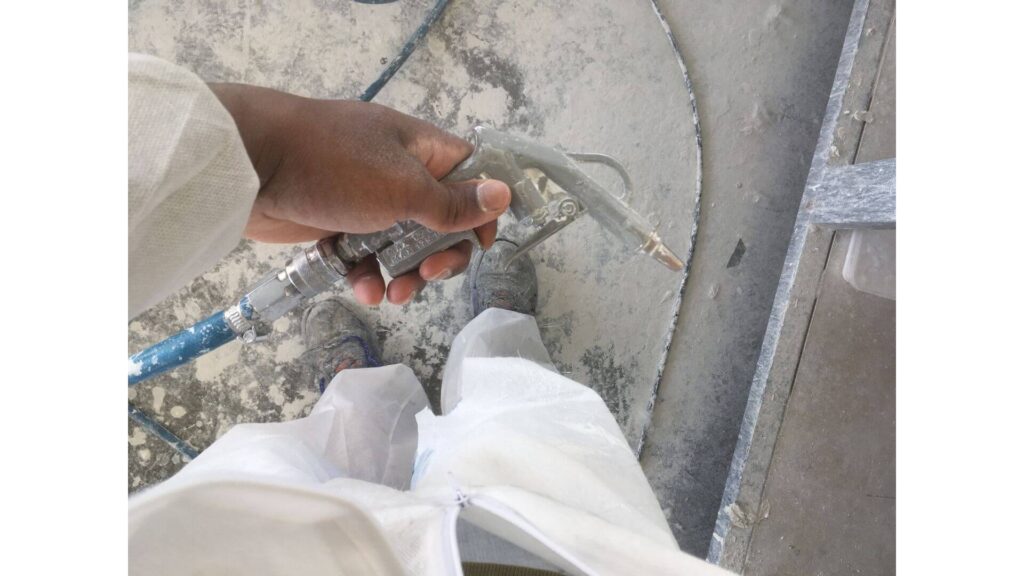Fiberglass on clothes typically appears as tiny, thin, and hard-to-see fibers that are usually pink, white, or light yellow in color. These tiny fibers can be difficult to spot due to their small size.
Identifying Fiberglass on Clothing
When trying to identify whether a substance on your clothing is fiberglass, look for the following characteristics:
- Color: Fiberglass fibers are typically light yellow or white.
- Size: The fibers are very small and thin, making them hard to see with the naked eye.
- Texture: Fiberglass has a slightly rough texture when touched.
If you suspect that your clothing has come into contact with fiberglass material, it’s essential to take action quickly to remove the fibers and prevent skin irritation.
Dangers of Fiberglass on Clothes
Fiberglass fibers can cause skin irritation, itching, and even rashes when they come into contact with your skin.
Inhaling these fibers can also lead to respiratory issues.
It’s crucial to remove fiberglass from your clothing as soon as possible to minimize these health risks.
==>> Also read: How to get fiberglass out of your skin?
Removing Fiberglass from Clothes
To remove fiberglass from your clothes, follow these steps:
- Shake the clothing outside to remove loose fibers.
- Use a vacuum cleaner with a HEPA filter to remove any remaining fibers.
- Wash the clothing separately in hot water with a strong detergent.
- Run the washing machine on an extra rinse cycle to ensure all fibers are removed.
- Dry the clothing in a dryer on high heat to kill any remaining fibers.
It’s important to note that while washing can remove most fiberglass fibers, some may remain embedded in the fabric. In such cases, it may be best to dispose of the clothing to avoid further exposure.
==>> See my complete guide about removing fiberglass from clothes here!
Using an Air Pipe: My favorite method

Using an air pipe to remove fiberglass particles from clothing is a practical solution to mitigate discomfort and potential skin irritation caused by fiberglass residue.
By directing a stream of air onto the affected clothing, the tiny, abrasive fibers are dislodged and carried away, minimizing contact with the skin. This method is efficient and safe, as it eliminates the need for physical contact or abrasive techniques that may exacerbate the problem.
Moreover, it offers a quick and convenient way to rid clothing of fiberglass remnants, ensuring comfort and peace of mind for individuals exposed to such materials.
Preventing Fiberglass Contamination

To prevent fiberglass from getting on your clothes in the first place, take the following precautions:
- Wear protective clothing, such as a disposable coverall, when working with fiberglass in insulation or boat construction.
- Avoid disturbing or cutting fiberglass, as this can cause the fibers to become airborne and settle on nearby surfaces, including clothing.
- If you must work with fiberglass, do so in a well-ventilated area and use a vacuum cleaner with a HEPA filter to clean up any debris.
Conclusion
Fiberglass on clothes appears as tiny, light-colored fibers that can cause skin irritation and respiratory issues.
If you suspect your clothing has been contaminated with fiberglass, remove the fibers promptly by shaking the garment outside, vacuuming, and washing it in hot water.
To prevent fiberglass contamination, wear protective clothing and avoid disturbing fiberglass. By taking these steps, you can protect your health and keep your clothes free of irritating fiberglass fibers.

Founder of BoatGenesis, Warren has hands-on experience in fiberglass boat repairs, marine equipment testing, and powerboat building. Learn more about Warren.




